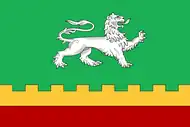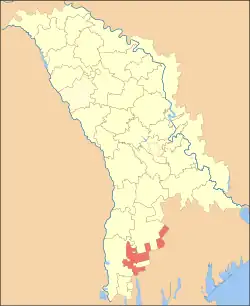Taraclia | |
|---|---|
District (Raion) | |
 Flag  Coat of arms | |
 | |
| Country | |
| Administrative center (Oraş-reşedinţă) | Taraclia |
| Government | |
| • Raion President | Vasile Plagov |
| Area | |
| • Total | 674 km2 (260 sq mi) |
| Population | |
| • Total | 37,357 |
| • Density | 55/km2 (140/sq mi) |
| Time zone | UTC+2 (EET) |
| • Summer (DST) | UTC+3 (EEST) |
| Area code | +373 74 |
| Car plates | TA |
Taraclia (Romanian pronunciation: [taraˈkli.a], Bulgarian: Тараклия) is a district (Romanian: raion) in the south of Moldova, with the administrative center at Taraclia.
As of 1 January 2012, its population was 44,100, 65.6% of whom were ethnic Bulgarians. The district covers an area of 674 km2 (260 sq mi) and has the lowest population density of all districts of Moldova.
History
The district was formed on November 11, 1940, with its center in the village of Taraclia, in the Moldavian SSR. Until October 16, 1949 it was part of the Cahul uyezd, after the abolition of the uyezd it passed to direct republican subordination.
Between January 31, 1952 and June 15, 1953 the area was part of Cahul county, after the abolition of the county division it returned to direct republican subordination.
On January 9, 1956 the territory of Taraclia district was almost doubled due to the annexation of parts of the territory of the abolished Kangazi district.
On December 25, 1962 a new division of the territory of the Republic was established. The Taraclia region was abolished and its territory was divided between the neighboring regions of Kagul, Komrat and Chadarlung.
On November 10, 1980, the district was restored with almost the same boundaries as in 1956, adding part of the territories of Vulkanesti and Chadarlung districts.
In the mid-1990s, after the creation of the autonomous territorial entity of Gagauzia, there was a mutual transfer of villages between Gagauzia and the Taraclia region. As a result of the transfer, the region was territorially divided into two unrelated parts.
In 1999, as part of the ongoing administrative reform, the region became part of the Kagul uyezd, but on October 22, 1999,[2] at the request of the majority of ethnic Bulgarians in the region, a separate Taraclia uyezd was created.
The Taraclia rajon has existed since 2003. Until February 2003, the area belonged to the now dissolved Cahul District (Județul Cahul) together with today's Rajon Cahul and Cantemir. As the center of the Bulgarian minority in Moldova, which accounts for about 66% of the population, today there are numerous Bulgarian cultural institutions and schools in Taraclia District. The Bulgarian language is also one of the languages of instruction at the Taraclia State University.
The regional authorities in Taraclia have long been demanding more autonomy rights for their region. In early 2014, a union with the autonomous region of Gagauzia was also discussed.[3] According to the regional president of Taraclia, numerous other localities, mostly inhabited by Bulgarians, from other parts of Moldova applied to join the Taraclia district.[4] Semi-independent of Moldova's central government, the rayon regional administration maintains separate relations with Russia.[5] Taraclia is considered a stronghold of pro-Russian political parties in Moldova.[6] Due to dissatisfaction with the Chișinău government, separatist tendencies have intensified in the region in recent years.[7]
Demographics
- Births (2010): 464 (10.5 per 1000)
- Deaths (2010): 562 (12.7 per 1000)
- Growth Rate (2010): –98 (–2.2 per 1000)
Ethnic groups
| Ethnic group | % of those who declared an ethnicity |
|---|---|
| Bulgarians | 66.1 |
| Moldovans * | 14.0 |
| Gagauz | 9.0 |
| Ukrainians | 5.2 |
| Russians | 4.5 |
| Romani | 0.5 |
| Romanians * | 0.2 |
| Other | 0.5 |
Footnote: * There is an ongoing controversy regarding the ethnic identification of Moldovans and Romanians.
Religion
- Christians – 96.6%
- Orthodox Christians - 94.3%
- Protestant – 2.3%
- Baptists – 1.3%
- Evangelicals – 0.5%
- Pentecostals – 0.3%
- Seventh-day Adventists – 0.2%
- Other – 1.7%
- No Religion – 1.3%
- Atheists – 0.4%
Politics
Traditionally in Taraclia district, political and electoral support for the PCRM is higher than the rest of the southern part of Moldova. Communists have the largest percentage of the Moldova votes in this district. But the last three elections communists saw a continuous decline in percentage.
During the last three elections AEI had an increase of 147.1%
| Year | AEI | PCRM |
|---|---|---|
| 2010 | 19.75% 3,845 | 69.61% 13,561 |
| July 2009 | 16.15% 3,183 | 80.70% 15,897 |
| April 2009 | 8.02% 1,556 | 69.41% 13,477 |
Elections
| Parties and coalitions | Votes | % | +/− | |
|---|---|---|---|---|
| Party of Communists of the Republic of Moldova | 13,561 | 69.61 | −11.09 | |
| Democratic Party of Moldova | 2,180 | 11,19 | +1.14 | |
| Liberal Democratic Party of Moldova | 1,217 | 6.25 | +3.28 | |
| United Moldova | 621 | 3.19 | +3.19 | |
| Humanist Party of Moldova | 483 | 2.48 | +2.48 | |
| Social Democratic Party | 425 | 2.18 | +0.22 | |
| Party Alliance Our Moldova | 256 | 1.31 | −0.62 | |
| Liberal Party | 192 | 1.00 | −0.20 | |
| Other Party | 548 | 2.79 | +1.60 | |
| Total (turnout 60.80%) | 19,656 | 100.00 | ||
References
- ↑ "Results of Population and Housing Census in the Republic of Moldova in 2014". National Bureau of Statistics of the Republic of Moldova. 2017. Retrieved 1 May 2017.
- ↑ ""ЗАКОН Nr. 650 от 22.10.1999 о внесении изменений и дополнений в Закон об административно-территориальном устройстве Республики Молдова"" [Law No. 650 of 22.10.1999 On Amending and Improving the Law on the Administrative-Territorial Organization of the Republic of Moldova].
- ↑ "gagauzinfo".
- ↑ Refugees, United Nations High Commissioner for. "Refworld | The Gagauz Referendum in Moldova: A Russian Political Weapon?". Refworld. Retrieved 23 July 2022.
- ↑ "Gagauzia's pro-Russian people open their arms to Ukrainian refugees | bne IntelliNews". www.intellinews.com. 20 April 2022. Retrieved 23 July 2022.
- ↑ "Tinact Magazine 2021 | Ghid Online de Remedii Naturiste". www.tinact.ro. Retrieved 23 July 2022.
- ↑ ""Noile tendințe separatiste de primăvară: "Autonomia bulgară" în Moldova | VOXPUBLIKA"" [New separatist tendencies in spring: "Bulgarian autonomy" in Moldova : VOXPUBLIKA]. Archived from the original on 21 September 2013. Retrieved 23 July 2022.